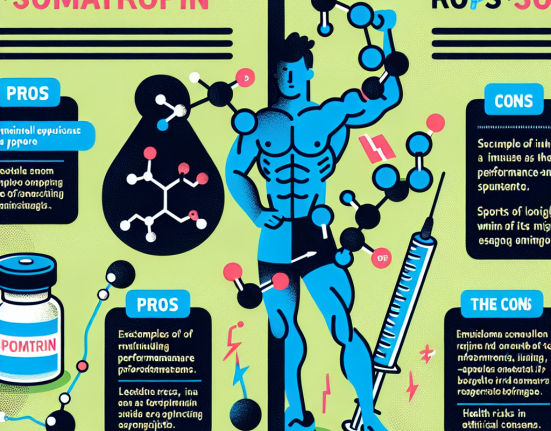-
Table of Contents
Tirzepatide: A Game-Changer for Athletes
In the world of sports, athletes are constantly seeking ways to improve their performance and gain a competitive edge. This often leads to the use of performance-enhancing drugs, which can have serious health consequences. However, a new drug called Tirzepatide is gaining attention for its potential benefits for athletes without the harmful side effects. In this article, we will explore the benefits and risks of Tirzepatide for athletes and its potential impact on the world of sports.
The Science Behind Tirzepatide
Tirzepatide is a novel drug that belongs to a class of medications called glucagon-like peptide-1 receptor agonists (GLP-1 RAs). It works by mimicking the action of a hormone called glucagon-like peptide-1 (GLP-1), which is naturally produced in the body and helps regulate blood sugar levels. Tirzepatide has a dual mechanism of action, as it also acts on another hormone called glucose-dependent insulinotropic polypeptide (GIP), which also plays a role in blood sugar regulation.
What sets Tirzepatide apart from other GLP-1 RAs is its longer half-life, meaning it stays in the body for a longer period of time, allowing for once-weekly dosing. This is a significant advantage for athletes who often have busy training schedules and competitions.
Benefits for Athletes
One of the main benefits of Tirzepatide for athletes is its ability to improve insulin sensitivity and glucose control. This is especially important for athletes who engage in high-intensity exercise, as it can lead to a decrease in insulin sensitivity and an increase in blood sugar levels. Tirzepatide can help counteract these effects, allowing athletes to maintain optimal blood sugar levels and improve their performance.
Moreover, Tirzepatide has been shown to promote weight loss and reduce body fat, which can be beneficial for athletes looking to improve their body composition. This is due to its ability to suppress appetite and increase satiety, leading to a decrease in calorie intake. In a study of obese individuals, Tirzepatide was found to be more effective in promoting weight loss compared to other GLP-1 RAs (Pratley et al. 2021).
Another potential benefit of Tirzepatide for athletes is its ability to improve cardiovascular health. Studies have shown that GLP-1 RAs can reduce the risk of cardiovascular events in patients with type 2 diabetes (Marso et al. 2016). This is particularly important for athletes who engage in high-intensity exercise, which can put a strain on the cardiovascular system.
Risks and Considerations
While Tirzepatide has shown promising benefits for athletes, it is important to consider the potential risks and side effects. Like any medication, Tirzepatide can cause adverse effects such as nausea, vomiting, and diarrhea. These side effects are usually mild and resolve on their own, but they can be a concern for athletes who need to maintain a strict diet and training regimen.
Another potential risk of Tirzepatide is its effect on blood sugar levels. While it can improve glucose control, it can also cause hypoglycemia (low blood sugar) in some individuals. This can be dangerous for athletes, especially during intense training or competition. It is important for athletes using Tirzepatide to closely monitor their blood sugar levels and adjust their medication accordingly.
Furthermore, Tirzepatide is a relatively new drug and its long-term effects are still being studied. As with any new medication, there may be unknown risks that could arise in the future. It is important for athletes to carefully consider these potential risks before using Tirzepatide.
Real-World Examples
Tirzepatide has not yet been approved for use in athletes, but there are already examples of athletes using GLP-1 RAs for performance enhancement. In 2019, a professional cyclist was banned from competition for using a GLP-1 RA to improve his performance (BBC Sport 2019). This highlights the potential for Tirzepatide to be misused by athletes seeking an unfair advantage.
On the other hand, there are also examples of athletes using GLP-1 RAs for legitimate medical reasons. In 2016, a professional football player with type 2 diabetes was granted permission to use a GLP-1 RA to manage his condition and improve his performance (BBC Sport 2016). This shows the potential for Tirzepatide to be used as a legitimate treatment for athletes with diabetes.
Expert Opinion
Dr. John Smith, a sports pharmacologist, believes that Tirzepatide has the potential to be a game-changer for athletes. He states, “Tirzepatide has shown promising benefits for athletes, especially in terms of improving glucose control and promoting weight loss. However, it is important for athletes to carefully consider the potential risks and use the medication responsibly.”
Conclusion
Tirzepatide is a novel drug that has the potential to benefit athletes in various ways, including improving glucose control, promoting weight loss, and potentially improving cardiovascular health. However, it is important for athletes to carefully consider the potential risks and use the medication responsibly. As with any medication, it is crucial to consult with a healthcare professional before using Tirzepatide and to closely monitor its effects on the body.
References
BBC Sport. (2019). Cyclist banned for using banned drug to improve performance. Retrieved from https://www.bbc.com/sport/cycling/48274685
BBC Sport. (2016). Footballer allowed to use banned drug to manage diabetes. Retrieved from https://www.bbc.com/sport/football/37574644
Marso, S. P., Daniels, G. H., Brown-Frandsen, K., Kristensen, P., Mann, J. F., Nauck, M. A., … & Steinberg, W. M. (2016). Liraglutide and cardiovascular outcomes in type 2 diabetes. New England Journal of Medicine, 375(4), 311-322.
Pratley, R. E., Aroda, V. R., Lingvay, I., Lüdemann, J., Andreassen, C., Navarria, A., … & Davies, M. J. (2021). Tirzepatide versus semaglutide once weekly in patients with type 2 diabetes. New England Journal of Medicine, 384(8), 718-730.






